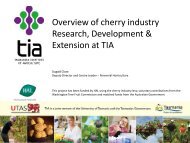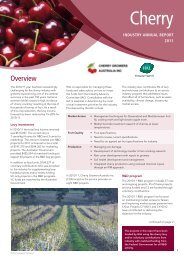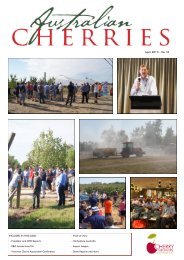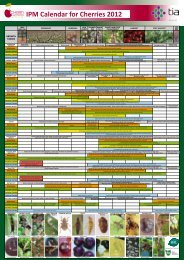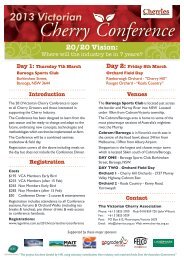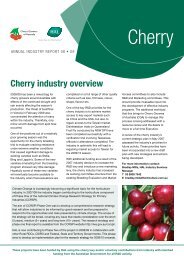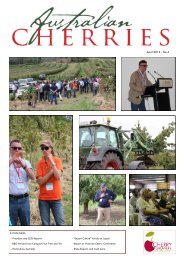February 2012 - No 3 - Cherry Growers Australia
February 2012 - No 3 - Cherry Growers Australia
February 2012 - No 3 - Cherry Growers Australia
Create successful ePaper yourself
Turn your PDF publications into a flip-book with our unique Google optimized e-Paper software.
Cherries and Climate Risk Workshop<br />
Production of quality cherries in your area, involves managing the risk of rain at harvest,<br />
frost, heat waves, poor weather at pollination, getting the right amount of winter chill and<br />
summer warmth, avoiding hail and wind damage and getting enough rain during winter and<br />
autumn to fill soil profiles and dams.<br />
This interactive workshop is designed to help you and involves a number of steps:<br />
1. Agree on a crop calendar for the region that shows the timing of leaf fall, bud swell,<br />
bud burst, flowering, shuck fall, shooting and harvest. This is based on the IPM calendar.<br />
2. We then use the calendar to identify the timing of the main weather events that can<br />
cause a problem (eg frost at flowering or rainy weather at harvest) and the main<br />
seasonal climate conditions (eg winter drought or insufficient chill over winter).<br />
3. As a group we use an interactive spreadsheet to score these risks based on the<br />
damage they cause and the frequency of the damage.<br />
4. We compare the scores with other regions that have conducted the exercise.<br />
5. We discuss what can be done to manage the different risks.<br />
6. Local weather data from the Bureau of Meteorology is used to assess the likelihood<br />
of the risks – in some cases this is run through additional models to calculate chilling<br />
units.<br />
7. We use the historical data to see if there are any trends in the likelihood of these<br />
risks and climate change projections to discuss future changes.<br />
The crop calendar is a powerful tool to link climate and weather science to the cherry orchard.<br />
SARDI climate applications will bring local climate data and climate analysis to the<br />
workshop.<br />
Following the workshop growers will receive a report with local climate analysis and the latest<br />
projections for future climate. Participants will work with other cherry growers to rank the<br />
weather and climate risks. This information will be collated for <strong>Cherry</strong> <strong>Growers</strong> <strong>Australia</strong>,<br />
DAFF and the Bureau of Meteorology. <strong>Cherry</strong> growers will have information on the frequency<br />
of some of the main weather and climate risks and most importantly discussion on how to<br />
manage these risks.<br />
This project is run by <strong>Cherry</strong> <strong>Growers</strong> <strong>Australia</strong> and conducted by the climate applications<br />
unit of the South <strong>Australia</strong>n Research and Development Institute (SARDI). This project is<br />
supported by funding from the <strong>Australia</strong>n Government Department of Agriculture, Fisheries<br />
and Forestry under <strong>Australia</strong>’s Farming Future. To set up a workshop for your region or area<br />
please contact:<br />
Contacts: Peter Hayman (SARDI)<br />
peter.hayman@sa.gov.au<br />
(08) 8303 9729<br />
Dane Thomas (SARDI)<br />
dane.thomas@sa.gov.au<br />
(08) 8303 9429



